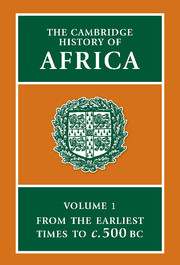Book contents
- Frontmatter
- 1 The palaeo-ecology of the African continent: the physical environment of Africa from earliest geological to Later Stone Age times
- 2 Origins and evolution of African Hominidae
- 3 The earliest archaeological traces
- 4 The cultures of the Middle Palaeolithic/Middle Stone Age
- 5 The Late Palaeolithic and Epi-Palaeolithic of northern Africa
- 6 The Later Stone Age in sub-Saharan Africa
- 7 The rise of civilization in Egypt
- 8 Beginnings of pastoralism and cultivation in north-west Africa and the Sahara: origins of the Berbers
- 9 The origins of indigenous African agriculture
- 10 Old Kingdom, Middle Kingdom and Second Intermediate Period in Egypt
- 11 Early food production in sub-Saharan Africa
- 12 Egypt, 1552–664 BC
- Bibliographical essays
- Bibliography
- Index
- Fig. 3.5 The distribution of sites known or believed to be older than 1.5 million years (i.e. Oldowan). (Modified from J. D. Clark 1967.)
- Fig. 3.6 The distribution of sites known or believed to be between 1.5 and 0.7 million years (i.e. Early Acheulian and Developed Oldowan).">
- Fig. 3.7 The location of Earlier Stone Age and Lower Palaeolithic sites thought to be between 0.7 and 0.1 million years old (i.e. Acheulian plus Developed Oldowan/Hope Fountain).
- Fig. 3.16 The ‘Zinjanthropus’ site at FLK, Bed I, Olduvai Gorge. A plan showing the distribution of an old ground–surface which was uncovered by excavation. A dense patch of discarded artifacts and introduced stones (manuports) coincides with a dense patch of broken–up animal bones. (After M. D. Leakey 1971.)
- Plate Section
- Plate Section
- Plate Section
- Plate Section">
- Plate Section
- Plate Section
- Plate Section
- References
11 - Early food production in sub-Saharan Africa
Published online by Cambridge University Press: 28 March 2008
- Frontmatter
- 1 The palaeo-ecology of the African continent: the physical environment of Africa from earliest geological to Later Stone Age times
- 2 Origins and evolution of African Hominidae
- 3 The earliest archaeological traces
- 4 The cultures of the Middle Palaeolithic/Middle Stone Age
- 5 The Late Palaeolithic and Epi-Palaeolithic of northern Africa
- 6 The Later Stone Age in sub-Saharan Africa
- 7 The rise of civilization in Egypt
- 8 Beginnings of pastoralism and cultivation in north-west Africa and the Sahara: origins of the Berbers
- 9 The origins of indigenous African agriculture
- 10 Old Kingdom, Middle Kingdom and Second Intermediate Period in Egypt
- 11 Early food production in sub-Saharan Africa
- 12 Egypt, 1552–664 BC
- Bibliographical essays
- Bibliography
- Index
- Fig. 3.5 The distribution of sites known or believed to be older than 1.5 million years (i.e. Oldowan). (Modified from J. D. Clark 1967.)
- Fig. 3.6 The distribution of sites known or believed to be between 1.5 and 0.7 million years (i.e. Early Acheulian and Developed Oldowan).">
- Fig. 3.7 The location of Earlier Stone Age and Lower Palaeolithic sites thought to be between 0.7 and 0.1 million years old (i.e. Acheulian plus Developed Oldowan/Hope Fountain).
- Fig. 3.16 The ‘Zinjanthropus’ site at FLK, Bed I, Olduvai Gorge. A plan showing the distribution of an old ground–surface which was uncovered by excavation. A dense patch of discarded artifacts and introduced stones (manuports) coincides with a dense patch of broken–up animal bones. (After M. D. Leakey 1971.)
- Plate Section
- Plate Section
- Plate Section
- Plate Section">
- Plate Section
- Plate Section
- Plate Section
- References
Summary
Considering the important contribution which the introduction and spread of food-production techniques have made to the subsequent development of African culture and history, it is particularly unfortunate that the available evidence by which these processes may be illustrated is sparse and its significance and meaning frequently inconclusive. This is not the place to discuss in detail the methodology of interpreting such evidence; suffice it to point out that most African prehistorians now appreciate the necessity of insisting upon the recovery of physical remains of domesticated animals or cultivated plants before food production in a given context can be regarded as proven. The experience of their colleagues elsewhere, particularly in the Near East and in south-east Europe, has shown them that there are virtually no aspects of material culture alone which are themselves incontrovertibly indicative of farming practice. Gone are the days when the African prehistorian could glibly imply the presence of food-production techniques from the occurrence of pottery or of ground stone tools. Pastoralism and food cultivation, although they often spread together, are not invariably linked, as many recent and contemporary African societies clearly attest.
Seddon (1968) has neatly categorized the various types of evidence which are available for illustrating the spread of food production. These are as follows:
direct archaeological evidence: i.e. the identifiable remains, recovered from stratified contexts, of domesticated animals or plants
indirect archaeological evidence: such as rock paintings and other artistic representations of domesticates or cultigens, or items of material culture which imply the presence of food-producing techniques (care must be exercised in the interpretation of artifacts of this last category since in remarkably few cases is the evidence conclusive)
secondary or non-archaeological evidence, based on botanical, zoological, linguistic or ethnographic data. Use of such data often involves the projection back into the past of recent observations from non-historical disciplines. In addition to the obvious dangers inherent in the unsupported use of such arguments, it is only rarely that the relevant evidence may be tied in to an archaeological sequence. The results of these investigations thus frequently remain in vacuo, without reference to their historical or cultural context, or to an absolute chronology.
Keywords
- Type
- Chapter
- Information
- The Cambridge History of Africa , pp. 770 - 829Publisher: Cambridge University PressPrint publication year: 1982
References
- 3
- Cited by



